The 100th anniversary of the First World War is now finished but the records will continue to be preserved at the Archives and accessible to current and future generations who want to know more about the time period. In addition, this blog will remain on our website as an additional resource.
May 2018 Posts:
- 28 May: The impact of the war on Manitoba's farms, May 1918
- 22 May: The S.S. Nascopie: Wartime Supply Vessel in the Arctic
- 14 May: Mina Mowat receives the Royal Red Cross at Buckingham Palace
- 7 May: “Remember Us Over Here:” Augusta Boulton, the Russell Red Cross Society, and the First World War
28 May 2018
The impact of the war on Manitoba's farms, May 1918
While many of our blog posts focus on soldiers’ letters and diaries, the impact of the First World War at home in Manitoba is also documented in other types of records held at the Archives of Manitoba. In the records of Valentine Winkler, MLA for Rhineland and Minister of Agriculture and Immigration in Premier T. C. Norris’ cabinet during the First World War, there are some interesting records about the impact of the war in Manitoba, particularly to Manitoba farms and farm families.
In our 27 November 2017 blog post, we featured letters written to and by Premier T. C. Norris regarding the impact of conscription on Manitoba’s farms and farmers.
An exception for farm workers had been granted for the 1917 harvest and then the 1918 planting, but this exemption was lifted in April 1918. In May 1918, farmers were writing to Manitoba Minister of Agriculture and Immigration Valentine Winkler, MLA for Rhineland, to ask him to intercede on their behalf.

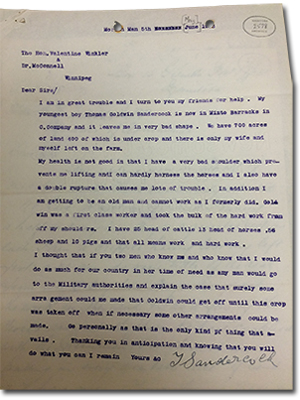
On 5 May Mr. T. Sandercock from Morden wrote to Winkler (through a Dr. McConnell) to ask him to go to the military authorities to ask that his youngest son be exempted to work on their family farm. The son, Thomas Goldwin Sandercock, was already at Minto Barracks, but his father desperately needed him back because he was in poor health with 700 acres, 400 of which were in crop, and only he and his wife were left on the farm.
We do not know whether Winkler contacted the military authorities on Sandercock’s behalf but, from the First World War service files held at Library and Archives Canada, we can confirm that Thomas Goldwin Sandercock attested on 14 May 1918, served in France, and was discharged in summer 1919.
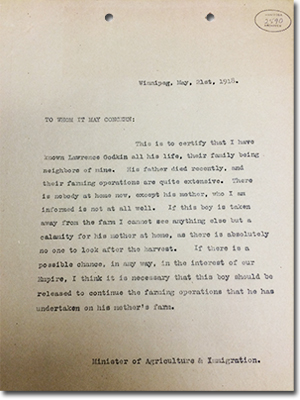
On 21 May, Winkler wrote a letter supporting another family in a similar situation. Lawrence Godkin’s father had recently died, leaving only his mother on the farm.
Winkler wrote:
“if there is a possible chance, in any way, in the interest of our Empire, I think it is necessary that this boy should be released to continue the farming operations.”
There is a First World War service file for a John Laurence Godkin from Morden, Manitoba who attested on 3 May 1918 and was discharged in January 1919. This may be the same Lawrence Godkin, but we cannot be certain.
There are many fascinating records from the time of the First World War in the Archives of Manitoba’s holdings, documenting the impact of the war both at home and away.
Search Tip: Search “Valentine Winkler” in Keystone for more information.
Feedback
E-mail us at [email protected] with a comment about this blog post. Your comments may be included on this page.
22 May 2018
The S.S. Nascopie: Wartime Supply Vessel in the Arctic
During the First World War, the Hudson’s Bay Company’s fur trade business carried on in North America. A number of our blog posts have featured the HBC’s steamer Nascopie and its role as a wartime supply ship in the service of European governments (12 Jan 2015, 15 June 2015, 10 July 2017, 2 Oct 2017).
Like most of the HBC’s ships employed in war business, the Nascopie also continued to carry out its duties as a supply ship for Arctic HBC fur trade posts between voyages overseas. On June 22, 1918, after delivering its cargo, the Nascopie left Archangel, Russia for Montreal, docking there on July 8. It left Montreal on July 20 and, after a brief stop in St. John’s, began its tour of posts along Hudson Bay and Straits on July 27.
While the Nascopie had a few intense experiences in its trans-Atlantic wartime crossings, the ship’s Arctic expeditions proved to be just as harrowing. On July 30, 1918, Percival Patmore, the Nascopie’s purser, writes in his diary:
Passed icebergs & in ice field all day. Cold wind. Put on all my winter clothing.
Two days later, while anchored in Port Burwell on Killiniq Island, at the northern tip of Labrador, an afternoon gale caused the harbour to fill with ice. The crew of the Nascopie had been discharging cargo from smaller boats for the HBC’s Port Burwell post, and were now unable to return to the ship. The crew’s only option was to return to the Nascopie on foot.
Patmore writes:
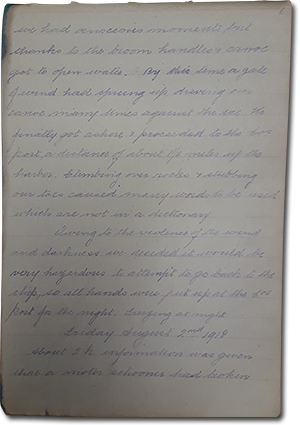
Many funny sights occurred when jumping from floe to floe, but all got safely back, though some were slightly wet when he or they missed (partly) a floe & in order to save themselves from a dunking, sprawled ¾ on the cake they intended to jump on & the other ¼ being in the water. At dark Capt. Mack, R. Parsons and self armed ourselves with broom handles & dragging a canoe along with us made for the shore. At times we had anxious moments, but thanks to the broom handles & canoe got to open water. By this time a gale of wind had sprung up, driving our canoe many times against the ice. We finally got ashore & proceeded to the Co.’s post, a distance of about 1 ½ miles up the harbor. Climbing over rocks & stubbing our toes caused many words to be used which are not in a dictionary.
The Hudson’s Bay Company Archives has some Admiralty hydrographic charts which show the tracks of HBC ships’ voyages.
Here is a portion of a 1918 Nascopie track chart showing the ship’s path around the northern tip of Labrador and its stop in Port Burwell, along with notations about the events mentioned above:
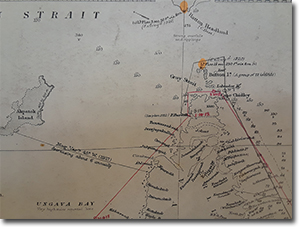
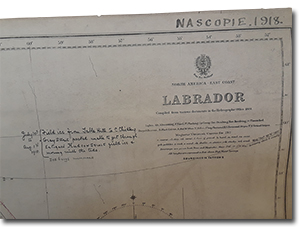
On November 11, armistice day, the Nascopie left Montreal for Liverpool. Although the war was over, the ship continued to make shipments to Russia’s north for European governments until 1921.
Search Tip: Search “Purser’s diaries” in Keystone to find out more about Percival Patmore’s diaries.
Feedback
E-mail us at [email protected] with a comment about this blog post. Your comments may be included on this page.
14 May 2018
Mina Mowat receives the Royal Red Cross at Buckingham Palace
Wilhelmina (Mina) Mowat Waugh was born in 1888. She graduated from Brandon General Hospital's Training School for Nurses in 1913. She enlisted as a nursing sister in the Canadian Army Medical Corps during the First World War and served in England, France, and Belgium. She returned to England following an injury and was posted to Moore Barracks Hospital, Shornecliffe when she recovered.
In 1918, Mina Mowat was awarded the Royal Red Cross 2nd Class, a decoration which recognized an individual’s devotion to nursing duties. She was invested with the Royal Red Cross by King George V at Buckingham Palace in July 1918. All of the women receiving the investiture were invited to meet the king’s mother, Queen Alexandra, at Marlborough House after the ceremony. These records – a telegram and a letter – document Mina Mowat’s invitations to the two events.
The telegram and the letter are in a scrapbook album compiled after the war by Mina Mowat’s husband, Richard Douglas Waugh.
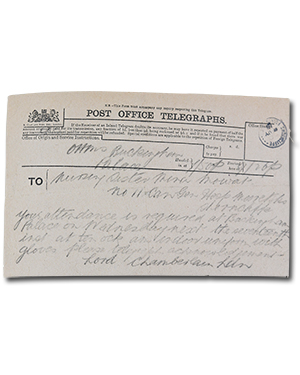
![Letter from War Office, Whitehall, S.W.1 to Miss M. Mowat dated 10-7-18. “Madam, I am directed to inform you that Her Majesty Queen Alexandra has expressed a wish that all ladies who attend an Investiture at Buckingham Palace to receive the decoration of the Royal Red Cross should afterwards proceed to Marlborough House to see her Majesty. I am accordingly to request that you will attend at Marlborough House at 12 noon on your return from Buckingham Palace. I am, Madam, Your obediant Servant. [signature]”](../../_images/ww1blog/2018/2018-05-14_sm_2.jpg)
Search Tip: Search Waugh family fonds in Keystone to find out more about the scrapbooks and other records in the collection.
Feedback
E-mail us at [email protected] with a comment about this blog post. Your comments may be included on this page.
7 May 2018
“Remember Us Over Here:” Augusta Boulton, the Russell Red Cross Society, and the First World War
The First World War was a significant turning point for the Canadian Red Cross. The Canadian Red Cross was incorporated in 1909 by the Canadian government to serve as the main humanitarian organization in Canada and with the outbreak of hostilities in August 1914, the number of local branches of the Red Cross grew across Canada as membership increased.
Women, who were not allowed to join the military at this time, were particularly active in the Red Cross. Augusta Boulton of Russell, Manitoba, was active in the Russell Red Cross Society. The Charles and Augusta Boulton family records held at the Archives of Manitoba include letters from soldiers who had received parcels sent by Augusta during her work with the Russell Red Cross Society.
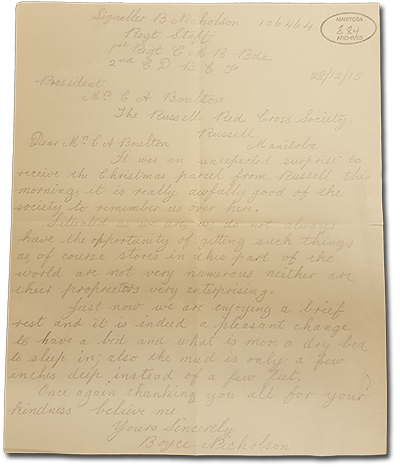
In one letter dated December 28, 1915, Boyce Nicholson, a soldier serving overseas, sent a thank you letter to Augusta.
It was an unexpected surprise to receive the Christmas parcel from Russell this morning, it is really awfully good of the [Red Cross] society to remember us over here. … Once again thanking you all for your kindness believe me.

Parcels were often sent to individual soldiers but, as is often the case in war, they may have not been around to receive them. When such an event occurred, the parcel’s contents were often distributed among the unit’s soldiers, as this January 2, 1916 letter from A. George Smellie demonstrates:
Yesterday I received the parcel sent by the members of the Russell Red Cross [Society]. And I have distributed them to the best of my ability to the different addresses enclosed. The ones I could not find owners for I gave around among the boys.
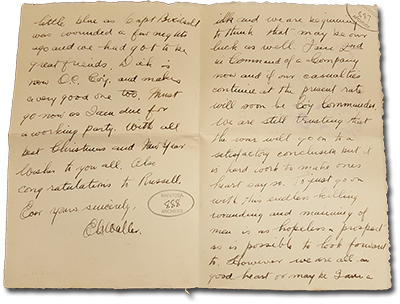
Due to the wartime trauma that soldiers experience, they would often describe their feelings about the War, as this December 18, 1915 letter from Lieutenant O'Grady shows:
We are still trusting that the war will go on to a satisfactory conclusion but it is hard work to make ones heart say so. To just go on with this endless killing, wounding and maiming of men is as hopeless a prospect as is possible to look forward to.
Throughout the First World War, the Red Cross sent medical supplies, socks, scarves, sweaters, and other articles of clothing. Other than donating large sums of money to refugees and local Red Cross societies such as the one in Russell, the Red Cross also packed food parcels for prisoners of war. In addition to Augusta Boulton’s correspondence, the Archives of Manitoba also contain the records of the Manitoba division of the Red Cross.
Search Tip: In Keystone, search “Boulton” to find the Charles and Augusta Boulton family fonds. Also, search “Canadian Red Cross” to find the records for the Manitoba Division of the Red Cross.
Feedback
E-mail us at [email protected] with a comment about this blog post. Your comments may be included on this page.




B. M. January 31, 2019
I came across the blog concerning the impact of the war on farm families by accident. I was quite excited to find this information as Thomas Goldwin Sandercock is my father. This is information I did not know previously.